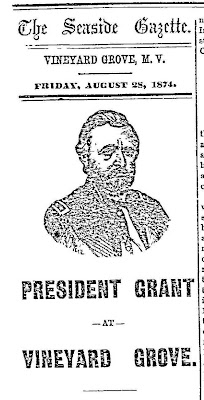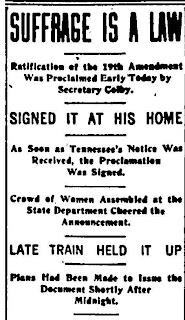
On Wednesday, August 19, 2015, the Martha’s
Vineyard, Oak Bluffs’ Campground will host its 146th Grand
Illumination Night. The first Illumination Night on
Saturday evening, August 14, 1869 was sponsored by the Oak Bluffs Land and
Wharf Company. The renowned annual event is famous for its traditional
Oriental paper lanterns ornately hung outside the many gingerbread cottages
that line the campground. However, the Grand Illumination’s intimate
association with the Campground was not always welcomed by its mid-19th century
religiously-inclined residents. Not only did they refrain from participating in
the secular event, they erected a picket fence to try to wall themselves off
from the world that had risen up around them. Historian Chris Stoddard writes, "In the eyes of many of the people attending the camp meeting,
this new group took on the form of the devil and a threat to the more serious
nature of the camp meeting." The first “Grand
Illumination” was sponsored by local Foxboro businessman, Erastus P. Carpenter.
During the summers of 1864
and 1865 Carpenter rented a cottage within the Camp Meeting grounds. He enjoyed
the revival meetings so much that he became desirous of purchasing a site for
permanent occupancy. Learning that this was against the rules of the Camp
Meeting Association he bought a lot outside of the grounds the following year. Recognizing
a potential land development boom, he soon formed a joint stock company and purchased
a 75 acre of wood and cleared land southeast of the Camp Meeting Association
property. The company investors included Edgartown residents Captain Shubael
Lyman Norton, Captain Ira Darrow, Captain Grafton Norton Collins, and William
Bradley.
 |
Erastus P. Carpenter
As president of the Oak
Bluffs Land and Wharf Company, Carpenter and his associates soon transformed
the undeveloped area into a popular summer destination place. The investors built
hundreds of affordable cottages, the Arcade, the Pagoda, the Union Chapel, the
Martha's Vineyard Railroad, the Sea View House as well as the Waban, Naushon,
Niantic and Ocean Parks.
|
The company placed its first
advertisement for the newly named resort of "Oak Bluffs" in the July
5, 1867 Vineyard Gazette. "Home By
The Seaside, Oak Bluffs. A New Summer Resort. One Thousand Lots for Sale. The Martha’s Vineyard Land and Wharf Company
having purchased the beautiful grove together with a large tract of land,
adjoining the Wesleyan Camp Ground, offer for sale, within the reach of all,
lots in their beautiful grounds, called "Oak Bluffs." The company
sold over 800 lots in the first three years.
 |
| E. P. Carpenter Cottage 1870 |
The summer residents
affiliated with the religious Camp Meeting Association were unhappy with the
success of this secular enterprise. The May 23, 1868 Vineyard Gazette reported,
“During the present year the number of
cottages erected on ‘this side of the fence,’ will fully equal, if not exceed those
in Wesleyan Grove. The High Board Fence – between the grounds of the Camp
Meetingers (sic) and Oak Bluffers is now in process of construction. We can
think that the camp Meeting Association will never regret this proceeding but
once - and that regret will be for all time. It is carrying matters a little
too far, and smacks somewhat strongly of Phariseeism."
The development soon encircled
the original religious camp meeting ground and so the main street was called
Circuit Avenue. Describing the public reaction to this series of events a
historian wrote, "Inside the Camp
Ground all was neighborly and hushed. Outside, quite suddenly, all was clamor
and commerce – a town of skating rinks, merry go rounds, theatres and hotels.
It was all so contrary to the spiritual business that drew the first pilgrims
there, and so bewildering to them. Eventually they put up a picket fence to try
to wall themselves off from the world that had risen up around them. The
speculation and energy that created the town of Oak Bluffs still animates the
spirit of the place today. And though the fence did not last, the Camp Ground,
right in the middle of it all, has managed to remain a place of almost
miraculous stillness and peace in the midst of the bustle."
The first Illumination Night on
Saturday evening, August 14, 1869 was sponsored by the Oak Bluffs Land and
Wharf Company. The Vineyard Gazette reported, "The illumination and fireworks at ‘Oak Bluffs,' on Saturday
evening last, was a very fine affair. Chinese and Japanese lanterns were
displayed in abundance, suspended from cottages and trees. There was a good
variety in the pieces at the fireworks. The Foxboro Brass Band, brought here by
the liberality of E. P. Carpenter, Esq., of Foxboro, discoursed fine music for
the occasion. Several thousands of people of both sexes were out to see and
hear." The initial festivity was called Governor's Day in honor of
Governor William Claflin who was on hand for the fete. Over the ensuing years,
the Vineyard Gazette referred to the annual event as the
"Illumination," and the identification remains to this day.

The event became more popular
each summer. During the summer of 1873 the Vineyard Gazette reported on the
"Illumination at Oak Bluff, Once
again entertainment was provided by for by E. P. Carpenter and the Foxboro
Brass Band. Among the notables present were Vice-President Henry Wilson, and
Governor Henry Howard of Rhode Island.” The following year, President
Ulysses S. Grant presided at the event. The Vineyard Gazette reported "The Illumination. In the evening the
President and Party were driven around the principal avenues on the Bluffs, to
witness the illumination and display of fire-works which had been gotten in his
honor. The procession headed by the Foxboro Brass Band… The whole city was
ablaze, or rather the Bluff’s ‘ward.’ The cottages of E. P. Carpenter, Dr.
Tucker, the Holmans, and others on Narragansett Avenue, and a host of others
all challenged the enthusiastic admiration of the multitude of
spectators."
 |
| The first sitting president to visit the Vineyard was Ulysses S. Grant,
right, pictured on the porch of a cottage in the Oak Bluffs Camp Ground
in 1874. (Credit: Martha's Vineyard Museum) |




The Grand Illumination has
been celebrated annually for 143 years. The early Illuminations added to the
alarm of the people 'inside the fence' of the encroaching ideas of
'commercialization' and a change to their quiet, isolated way of life. With the
passage of time, the wooden fence that once physically shunned out the lights
and festivities of the Illumination has become like a pond ripple that each
year carries anew the light and joy to all who wade into its waters.
 |
| E. P. Carpenter Cottage 1870 |
 |
| E. P. Carpenter Cottage 2012 |

























